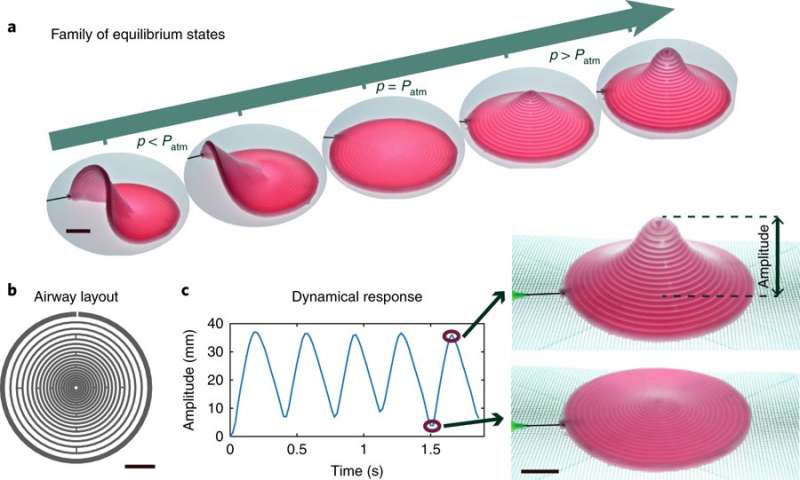November 20, 2018 report
Combining pneumatics with a hydrogel to create a baromorph—for soft robotics

A small team of researchers at ESPCI Paris has come up with a way to combine pneumatics with a hydrogel to create a baromorph for soft robotics applications—a baromorph is a soft material that self-configures when inflated. In their paper published in the journal Nature Materials, the group describes their research and their geometric creations. Efi Efrati with the Weizmann Institute of Science has written a News and Views piece on the work done by the team in the same journal issue.
In the never-ending quest to create robots that are ever more capable, roboticists have often been inspired by creatures that nature has designed. Attempting to mimic humans is a popular research area, as is copying four-legged creatures. Efrati notes that most such animals have one thing in common—stiff parts of their anatomy working against other stiff parts produce motion—bones in joints, for example. But as Efrati also notes, there is another area of research focused on the development of softer components that are manipulated without stiffer components—like jellyfish, for example, or flowers. Unfortunately, progress in this area has been rather slow—soft machines tend to respond slowly due to actuation issues. And they also tend to have limited degrees of motion and wear out quickly. In this new effort, the researchers have come up with a novel approach to creating soft machines—combining the bendability of hydrogels with the power of air pressure. They call their creations baromorphs, and they have demonstrated that they can be used to create soft-machines in wide variety of shapes.
Each baromorph is essentially a sheet of hydrogel with channels inside of it. In its initial relaxed state, it is typically flat. When air is pumped in, it is routed through the channels in such a way as to inflate the baromoph into a desired shape. The channels are designed using a computer program, which also handles the formation of the resultant product. To prove the viability of their method, the researchers created baromorphs that were shaped like bowls, a saddle and even a human face.
More information: Emmanuel Siéfert et al. Bio-inspired pneumatic shape-morphing elastomers, Nature Materials (2018). DOI: 10.1038/s41563-018-0219-x
Journal information: Nature Materials
© 2018 Science X Network





















